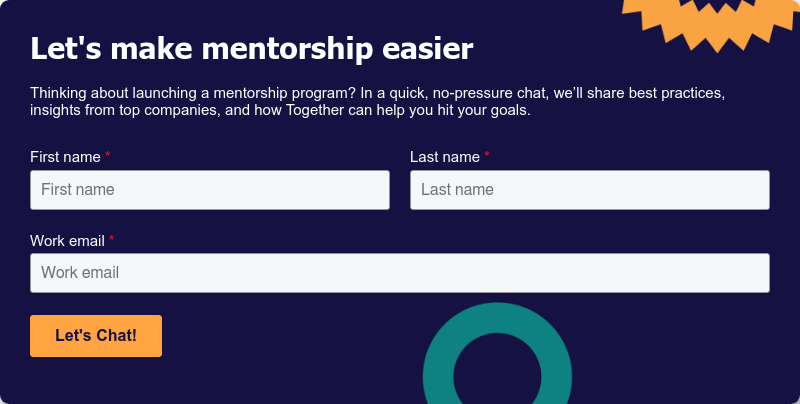As a company, your most prized assets are your people. That’s why it’s so important to invest in different ways to help them develop and grow.
Learning and development opportunities continue to be one of the top retention factors and research shows that companies who invest in those opportunities are better at keeping top talent. Not all people development initiatives have to be structured seminars or courses, though. While those training methods are still valuable, more informal training can help you and your employees see even greater benefits.
In this article, we’ll explore what informal training is, how it benefits your company and employees, and examples of informal learning in the workplace.
Let’s get started!
What is informal training?
Informal training refers to unstructured and unofficial sharing of knowledge in the workplace—sometimes also called informal or asynchronous learning.
This type of training puts the employee in the driver’s seat of their own development. They choose what, where, and when they learn rather than follow lesson plans, schedules, and learning outcomes.
Informal training can take many different forms, such as knowledge transfer between senior and junior employees in a job shadowing or mentorship program, a new hire learning from a more experienced employee in an onboarding buddy program, or even just watching video tutorials when they have downtime.
Informal learning opportunities are more common in companies who build and promote a learning culture, where employees are encouraged to collaborate and learn from one another more freely.
The difference between formal and informal training
Formal and informal training couldn’t be more different. Here are some of the key differentiators:
- Structure: Formal training programs (compliance training, etc.) involve structured learning. The learning objectives are defined from the outset and the employees have little choice but to work towards those objectives. With informal training, it’s the opposite.
- Trainers: Both approaches may involve a senior colleague teaching their juniors. However, only formal training involves bringing in outside trainers with set lesson plans to teach employees.
- Testing: A formal employee development program involves tests that ensure knowledge retention. Informal training helps knowledge retention through practical application of new skills and repetition.
- Pace: Informal training is self-paced while formal training isn’t. The latter type of training is time-sensitive and involves a schedule and deadline.
- Autonomy: Employees have greater autonomy when learning informally than when they’re being formally trained. This can provide benefits. We’ll discuss these benefits in the section below.
- Knowledge sources: Formal training usually involves a sole instructor teaching a company’s employees. That’s not the case when an employee learns informally.
Many companies find a combined approach of formal and informal training to be most effective.
The benefits of informal training in the workplace
Now that you know the difference between formal and informal training, let’s discuss some of the benefits informal learning experiences provide. Three of the most prominent ones that come to mind include:
- Less pressure: Informal learning doesn’t put as much pressure on the learner. Your employees don't have to worry about their knowledge being tested or deadlines.
- Greater autonomy for learners: As already mentioned, informal training gives the employee more control over their development. They can set their own learning goals, training methods, and knowledge sources. Having greater autonomy over what (and how) they learn helps an employee stay focused.
- Varied sources of learning: In an environment that fosters informal learning, an employee can learn from multiple sources, including their colleagues. Employees get a more organic and practical education.
- Adaptive learning: Employees can tailor it to how they learn best—whether it’s peer learning, experiential learning, or self-guided training materials.
- Cost-effective: Informal learning doesn’t require as many resources or structured programs like formal training does. So less budget, less administrative time and effort, and you don’t need to rely on outside resources like trainers and consultants.
- Supports a learning culture: Giving employees more power to guide their learning makes them more likely to seek out growth opportunities, supporting a learning culture at your company.
- Improved relationships: The informal knowledge-sharing between employees can also help improve workplace relationships.
Of course, informal training provides many more benefits than the ones listed above. Depending on your industry, company culture, and your company’s employee development goals, you’ll reap different benefits. Read about informal learning examples in the next section.
4 informal training examples
So, how can you create more informal training opportunities in your company? Let’s explore informal learning examples worth incorporating into your company culture.
1. Mentorship
Mentorship programs in the workplace are excellent informal learning opportunities worth implementing in your organization.
In a mentor match, experienced employees can teach their younger counterparts the ins and outs of the job. The mentor imparts knowledge, experience, and provides the mentee with guidance towards their own goals.
As informal training examples go, mentorship is an excellent choice for many reasons:
- Builds stronger bonds: Mentorship helps create deeper, more meaningful connections at work. The mentor becomes a trusted guide while the mentee often offers a fresh perspective and enthusiasm.
- Encourages knowledge sharing: Mentorship helps break down information silos in your company. Rather than risking knowledge loss when an experienced employee leaves, mentorship helps preserve that knowledge, leaving it in the capable hands of the next generation. In fact, 89% of mentees go on to become mentors themselves.
- Accelerates employee development: Informal guidance helps mentees build both technical and soft skills. With personalized direction and real-world insights from their mentors, employees gain confidence and competence faster than through formal training alone.
2. Job shadowing
Job shadowing is a hands-on learning approach that is similar to mentorship—an employee learns from their more experienced colleague. The difference between the two on-the-job learning methods, however, is that shadowing typically involves a new employee watching a more tenured one or one who is in a different role.
Mentorship often emphasizes guidance and ongoing support, while job shadowing typically involves a more short-term relationship where an employee observes another doing their day-to-day responsibilities and learning the ropes. Shadowing is also common during internship programs where the intern is just starting to learn the relevant skills.
There are many benefits of job shadowing for both the shadower and the shadowee. For starters, they get a fly-on-the-wall perspective of how their colleague performs their work duties. This helps them learn new skills much quicker than if they were left to their own devices.
Also, shadowing promotes curiosity and reflection in new employees. For example, an employee that shadows their senior during a work meeting can reflect on what they observed.
3. Team-building activities
Team building activities are an excellent way to encourage informal learning. You can organize them every once in a while to strengthen the bonds between co-workers and company departments. Team building activities are just as effective in remote or hybrid workplaces, too.
Research found that team building activities are a valuable part of informal training and company culture. Companies that create opportunities for team building see a 36% higher employee retention rate and 30% higher employee engagement rates.
Some examples of these team building exercises include:
- Virtual break rooms: Virtual break rooms set up through Zoom or Teams are excellent for remote teams. Your employees can pop into them during their break to chat with their co-workers online. These break rooms can promote informal training in the workplace by providing a virtual space where remote employees can gather to seek help for a work-related problem from their colleagues and brainstorm solutions together.
- Cook-offs: Cook-offs are great for bringing large teams together over delicious food or barbecue. This team building activity can get co-workers from different departments talking. The leisurely ambiance encourages informal discussions of work-related issues.
- Company retreats: Like cook-offs, company retreats can help to get employees from different departments talking. The informal conversations during the period of rest and relaxation may prove insightful when everyone returns to the office.
As the above examples reveal, team building activities aren’t only good for informal training. They provide benefits like reducing employee stress, improving innovation and collaboration, and strengthening colleague bonds.
4. Asynchronous training
Asynchronous training is quickly becoming a core part of learning and development strategies. It offers employees a flexible way to learn at their own pace.
This approach is one of the most important examples of informal learning in the workplace because it is 100% employee-driven. They can build on existing skills or learn new ones outside the constraints of traditional training.
One key benefit is how flexible it is. Employees can access material virtually anytime and anywhere, allowing them to fit learning time into their busy schedules. This often leads to higher engagement and adoption rates for your training initiatives.
Here are a few examples of informal education using asynchronous learning:
- On-demand videos: Employees watch pre-recorded sessions or demonstrations to learn specific skills or concepts whenever it’s convenient for them. Since it’s prerecorded, employees can rewind to review content again or skip over the parts that aren’t relevant to them.
- E-learning: Online learning platforms are another way your employees can learn anytime, anywhere, and at their own pace. Plus, it’s easy for you, the administrator, to see participation, completion rates, and other measurables to track the success of your initiative.
- Knowledge-sharing portals: Company-wide forums or wikis make it easy for employees to access or share knowledge within your company. It offers one place to get answers fast.
- Podcasts and webinars: Providing access to a library of on-demand webinars or podcasts that are industry or role-specific helps equip employees with up-to-date knowledge.
- Simulations and quizzes: Gamified learning is a way to keep employees engaged in their informal training while applying their newly-learned skills.
Include informal training in your L&D strategy
Introducing an informal learning culture into your workplace can only provide benefits. Allowing your employees greater freedom to learn and grow how and when they want means higher retention, better engagement, and closing skill gaps. So, consider incorporating mentoring activities, a job shadowing program, team-building activities, and asynchronous learning opportunities into your workplace.
Want to get started? Together’s mentoring software—as well as our content and resource, events, and employee engagement tools—can help.
Talk to one of our experts—book a demo today!

.png)

.svg)







.svg)

